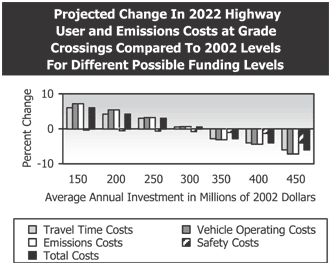U.S. Department of Transportation
Federal Highway Administration
1200 New Jersey Avenue, SE
Washington, DC 20590
202-366-4000

Exhibit ES56A is a bar graph that shows the projected change in 2022 highway user and emissions costs at grade crossings compared to 2002 levels for different possible funding levels. The vertical axis shows three percent changes: 10, 0, and -10. The horizontal bar measures average annual investment in millions of 2002 dollars from 150 to 450 in increments of $50 million. For each increment there are five bars representing different costs. At $150 million in average annual investment, there is a 6 to 7 percent change in travel time costs, vehicle operating costs, emissions costs, and total costs, while there almost no percent change in safety costs. At $200 million in average annual investment, there is a 4 to 5 percent change in travel time costs, vehicle operating costs, emissions costs, and total costs, while there is a -0.5 percent change in safety costs. At $250 million in average annual investment, there is a 3 percent change in travel time costs, vehicle operating costs, emissions costs, and total costs, while there is a -1 percent change in safety costs. At $300 million in average annual investment, there is a 0 to 1 percent change in travel time costs, vehicle operating costs, emissions costs, and total costs, while there is a -0.5 percent change in safety costs. At $350 million in average annual investment, there is a -3 to -4 percent change in travel time costs, vehicle operating costs, emissions costs, and total costs, while there is a -1 percent change in safety costs. At $400 million in average annual investment, there is a -4 to -5 percent change in travel time costs, vehicle operating costs, emissions costs, and total costs, while there is a -1.5 percent change in safety costs. And at $450 million in average annual investment, there is a -7 to -8 percent change in travel time costs, vehicle operating costs, emissions costs, and total costs, while there is a -3 percent change in safety costs.
Back
to Executive Summary